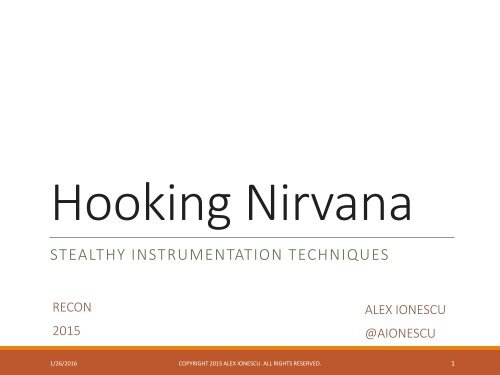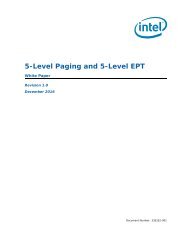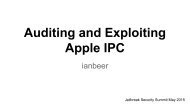Create successful ePaper yourself
Turn your PDF publications into a flip-book with our unique Google optimized e-Paper software.
<strong>Hooking</strong> <strong>Nirvana</strong><br />
STEALTHY INSTRUMENTATION TECHNIQUES<br />
RECON<br />
2015<br />
ALEX IONESCU<br />
@AIONESCU<br />
1/26/2016 COPYRIGHT 2015 ALEX IONESCU. ALL RIGHTS RESERVED. 1
WHO AM I?<br />
Chief Architect at CrowdStrike, a security startup<br />
Previously worked at Apple on iOS Core Platform Team<br />
Co-author of Windows Internals 5 th and 6 th Editions<br />
Reverse engineering NT since 2000 – main kernel developer of ReactOS<br />
Instructor of worldwide Windows Internals classes<br />
Conference speaking:<br />
◦ Recon 2015-2010, 2006<br />
◦ SyScan 2015-2012<br />
◦ NoSuchCon 2014-2013, Breakpoint 2012<br />
◦ Blackhat 2015, 2013, 2008<br />
For more info, see www.alex-ionescu.com<br />
1/26/2016 COPYRIGHT 2015 ALEX IONESCU. ALL RIGHTS RESERVED. 2
WHAT THIS TALK IS ABOUT<br />
Five different technologies in Windows<br />
◦ Time Travel Debugging / iDNA (<strong>Nirvana</strong>)<br />
◦ Application Verifier (AVRF)<br />
◦ Minimalized Windows (MinWin)<br />
◦ Application Compatibility Engine (ShimEng)<br />
◦ Control Flow Guard (CFG)<br />
Their intended use in the system<br />
How their use can be misappropriated or leveraged for instrumenting<br />
binaries and hooking them early (or late)<br />
1/26/2016 COPYRIGHT 2015 ALEX IONESCU. ALL RIGHTS RESERVED. 3
PAST RESEARCH<br />
Some of these techniques have partially been exposed before<br />
For example, the <strong>Nirvana</strong> hook was discovered by Nick Everdox<br />
◦ http://www.codeproject.com/Articles/543542/Windows-x-system-service-hooksand-advanced-debu<br />
◦ But Windows 10 totally changes the interface…<br />
MinWin has some good information from QuarksLab and ARTeam<br />
◦ http://blog.quarkslab.com/runtime-dll-name-resolution-apisetschema-part-i.html<br />
◦ http://www.xchg.info/wiki/index.php?title=ApiMapSet<br />
◦ But they used manually reverse engineered symbols, and Windows 10 changed<br />
them<br />
1/26/2016 COPYRIGHT 2015 ALEX IONESCU. ALL RIGHTS RESERVED. 4
MORE PAST RESEARCH<br />
CFG has a Whitepaper from TrendMicro, and a presentation from MJ0011<br />
◦ http://sjc1-te-ftp.trendmicro.com/assets/wp/exploring-control-flow-guard-inwindows10.pdf<br />
◦ http://www.powerofcommunity.net/poc2014/mj0011.pdf<br />
◦ But they don’t cover the hooking capabilities<br />
AVRF is a mystery, except to TSS, a Russian Hacker:<br />
◦ http://kitrap08.blogspot.ca/2011/04/application-verifier.html<br />
◦ Not many details<br />
Only one Chinese Forum site talks about the Shim Engine hooks:<br />
◦ http://bbs.pediy.com/showpost.php?p=1199075&postcount=1<br />
◦ Accurate for Windows 8<br />
1/26/2016 COPYRIGHT 2015 ALEX IONESCU. ALL RIGHTS RESERVED. 5
WINDOWS 10 CHANGES<br />
So we’ll specifically take a look at new changes in Windows 10<br />
◦ New data structures and types<br />
◦ New version numbers<br />
◦ New API parameters/exports/techniques<br />
◦ Semantic/functional changes<br />
1/26/2016 COPYRIGHT 2015 ALEX IONESCU. ALL RIGHTS RESERVED. 6
OUTLINE<br />
MinWin Hooks<br />
<strong>Nirvana</strong> Hooks<br />
CFG Hooks<br />
AVRF Hooks<br />
Shim Hooks<br />
QA & Wrap-up<br />
1/26/2016 COPYRIGHT 2015 ALEX IONESCU. ALL RIGHTS RESERVED. 7
MinWin<br />
1/26/2016 COPYRIGHT 2015 ALEX IONESCU. ALL RIGHTS RESERVED. 8
What is MinWin?<br />
MinWin is an internal Microsoft project to re-architect the many layers<br />
of the Windows Operating System<br />
◦ Goal is to return to the original layering interface that Dave Cutler wanted –<br />
a low-level microkernel, a set of base services, and a subsystem of additional<br />
functionality<br />
First “shipped” in Windows 7<br />
◦ People started noticing strange new DLL<br />
names as well as import tables<br />
◦ Came in as an “API Contract” mechanism<br />
used by user-mode applications<br />
Enhanced in Windows 8<br />
◦ Supported by the kernel and even boot<br />
loader<br />
Made “One Core” possible in Windows 10<br />
1/26/2016 COPYRIGHT 2015 ALEX IONESCU. ALL RIGHTS RESERVED. 9
What are API Sets?<br />
1/26/2016 COPYRIGHT 2015 ALEX IONESCU. ALL RIGHTS RESERVED. 10
API Set Redirection (Win 7)<br />
One single ApiSetSchema.dll file contains the API Set mappings in a PE<br />
section called .apiset<br />
Windows kernel, at boot, calls PspInitializeApiSetMap<br />
◦ Verifiers that this is a signed driver image (subject to KMCS)<br />
◦ Finds required PE section<br />
◦ Maps file as PspApiSetMap, stores section as PspApiSetOffset and<br />
PspApiSetSize<br />
Each time a process launches, PspMapApiSetView is called<br />
◦ Maps the section using PAGE_READONLY, using the PspApiSetOffset<br />
◦ NOTE: Image is not mapped using SEC_NO_CHANGE nor using MmSecureVirtualMemory<br />
◦ Writes the base address in Peb->ApiSetMap<br />
Loader (Ntdll.dll) parses the API Set during any DLL load operation<br />
◦ LdrpApplyFileNameRedirection<br />
1/26/2016 COPYRIGHT 2015 ALEX IONESCU. ALL RIGHTS RESERVED. 11
API Set Redirection (Win 7)<br />
Windows 7 included about 35 redirected DLLs<br />
Format of ApiSetMap was documented in apiset.h (Version 2.0)<br />
typedef struct _API_SET_NAMESPACE_ARRAY_V2 {<br />
ULONG Version;<br />
ULONG Count;<br />
API_SET_NAMESPACE_ENTRY_V2 Array[ANYSIZE_ARRAY];<br />
} API_SET_NAMESPACE_ARRAY_V2, *PAPI_SET_NAMESPACE_ARRAY_V2;<br />
typedef struct _API_SET_NAMESPACE_ENTRY_V2 {<br />
ULONG NameOffset;<br />
ULONG NameLength;<br />
ULONG DataOffset;<br />
} API_SET_NAMESPACE_ENTRY_V2, *PAPI_SET_NAMESPACE_ENTRY_V2;<br />
DLL names include API Set Name (api-ms-win) and Version (LX-X-X)<br />
1/26/2016 COPYRIGHT 2015 ALEX IONESCU. ALL RIGHTS RESERVED. 12
API Set Redirection (Win 8)<br />
Windows 8 introduces 365 new redirected DLLs<br />
Includes concept of “Extension” Sets, not just “API” Sets<br />
Extensions are used by API Set libraries based on their presence (using<br />
ApiSetQueryApiSetPresence) and provide functionality that may exist<br />
only on certain operating systems<br />
◦ New loader function: LdrpPreprocessDllName<br />
For example, Kernel Transaction Manager is now an extension in<br />
Windows 8, since Windows Phone 8 does not have it<br />
◦ Base library: Tm.sys -> Extension Set: ext-ms-win-ntos-tm-L1-0-0.dll<br />
Now loaded at boot by Winload.exe inside OslLoadApiSetSchema<br />
◦ Additional API Sets can be loaded, and merged into the final schema<br />
◦ Schema written in LoaderBlock->Extension->ApiSetSchema(Size)<br />
◦ MmMapApiSetView now uses SEC_NO_CHANGE<br />
1/26/2016 COPYRIGHT 2015 ALEX IONESCU. ALL RIGHTS RESERVED. 13
API Set Redirection (Win 8)<br />
Data structures changed to V4 (V3 in Windows 8, V4 in Windows 8.1)<br />
typedef struct _API_SET_NAMESPACE_ARRAY {<br />
ULONG Version;<br />
ULONG Size;<br />
ULONG Flags;<br />
ULONG Count;<br />
API_SET_NAMESPACE_ENTRY Array[ANYSIZE_ARRAY];<br />
} API_SET_NAMESPACE_ARRAY, *PAPI_SET_NAMESPACE_ARRAY;<br />
typedef struct _API_SET_NAMESPACE_ENTRY {<br />
ULONG Flags;<br />
ULONG NameOffset;<br />
ULONG NameLength;<br />
ULONG AliasOffset;<br />
ULONG AliasLength;<br />
ULONG DataOffset;<br />
} API_SET_NAMESPACE_ENTRY, *PAPI_SET_NAMESPACE_ENTRY;<br />
1/26/2016 COPYRIGHT 2015 ALEX IONESCU. ALL RIGHTS RESERVED. 14
API Set Redirection (Win 10)<br />
Windows 10586 has 641 redirected DLLs (up from 622 in 10240)<br />
Includes all of the support for One Core now<br />
◦ XBOX DLLs<br />
◦ Windows Phone DLLs<br />
◦ Windows IoT DLLs<br />
◦ Windows Server DLLs<br />
◦ Windows Client DLLs<br />
API Structures have changed to V6 Format (breaking change)<br />
◦ Structure is no longer has an array, but rather an offset to the array<br />
◦ Also includes offset to an array of hashes<br />
◦ Then, hash length added to each entry in the array<br />
◦ Aliases replaced by array of names<br />
Will post tool on blog for beer<br />
1/26/2016 COPYRIGHT 2015 ALEX IONESCU. ALL RIGHTS RESERVED. 15
Special Kernel Base Handling<br />
When the loader (Ntdll.dll) loads kernel base, it also calls<br />
LdrpSnapKernelBaseExtensions<br />
This parses all of the delay load descriptors for KernelBase.dll<br />
Looks for any which start with ext-<br />
Finds the API Set Hosts for those extensions, and checks if any resolve<br />
to Kernel32.dll<br />
◦ Load them if so, by calling LdrpResolveDelayLoadDescriptor<br />
1/26/2016 COPYRIGHT 2015 ALEX IONESCU. ALL RIGHTS RESERVED. 16
Parsing Windows 10 API Set<br />
peb = NtCurrentTeb()->ProcessEnvironmentBlock;<br />
ApiSetMap = peb->Reserved9[0]; // ApiSetMap<br />
nsEntry = (PAPI_SET_NAMESPACE_ENTRY)(ApiSetMap->EntryOffset + (ULONG_PTR)ApiSetMap);<br />
for (i = 0; i < ApiSetMap->Count; i++)<br />
{<br />
nameString.Length = (USHORT)nsEntry->NameLength;<br />
nameString.Buffer = (PWCHAR)((ULONG_PTR)ApiSetMap + nsEntry->NameOffset);<br />
valueEntry = (PAPI_SET_VALUE_ENTRY)((ULONG_PTR)ApiSetMap + nsEntry->ValueOffset);<br />
for (j = 0; j < nsEntry->ValueCount; j++)<br />
{<br />
valueString.Buffer = (PWCHAR)((ULONG_PTR)ApiSetMap + valueEntry->ValueOffset);<br />
valueString.Length = (USHORT)valueEntry->ValueLength;<br />
nameString.Length = (USHORT)valueEntry->NameLength;<br />
nameString.Buffer = (PWCHAR)((ULONG_PTR)ApiSetMap + valueEntry->NameOffset);<br />
}<br />
valueEntry++;<br />
}<br />
nsEntry++;<br />
1/26/2016 COPYRIGHT 2015 ALEX IONESCU. ALL RIGHTS RESERVED. 17
Windows 10 API Sets<br />
1/26/2016 COPYRIGHT 2015 ALEX IONESCU. ALL RIGHTS RESERVED. 18
Modifying the API Set Map<br />
First, decide which APIs you would like to hook<br />
◦ https://msdn.microsoft.com/en-us/library/windows/desktop/<br />
hh802935(v=vs.85).aspx provides a complete listing of which APIs are in which<br />
API Sets<br />
◦ Even undocumented ones are shown!<br />
Parse the API Set Map and locate the API Set Host that contains the API to<br />
hook<br />
Replace the string associated with the Value Entry with your own custom<br />
DLL<br />
Careful: Value Entry Names are aliased! Changing the *buffer* will redirect<br />
multiple API Set Hosts<br />
Instead, allocate additional memory past the end of the API Set Map, and<br />
change the offset to your new blob<br />
1/26/2016 COPYRIGHT 2015 ALEX IONESCU. ALL RIGHTS RESERVED. 19
Gotchas!<br />
API Set Map is mapped as PAGE_READONLY<br />
◦ Windows 8 and higher will not allow VirtualProtect due to SEC_NO_CHANGE<br />
◦ Easier modification: Edit the PEB itself<br />
Steps:<br />
◦ Read existing API Set Map Size<br />
◦ Allocate identical buffer, plus one page<br />
◦ Copy existing API Set Map<br />
◦ Make required changes in the copy, including creating new offsets<br />
◦ Point Peb->ApiSetMap to the copy<br />
Problem #2: All API Set Hosts are assumed to be in %SYSTEMROOT%<br />
◦ Workaround: prefix API Dll Name with “\spool\drivers\color\”<br />
Problem #3: If hook DLL is importing kernel32.dll or advapi32.dll, then<br />
these imports will be subject to redirection too, and cause self-redirect<br />
◦ Workaround: Build custom .lib file that points directly to API Set Host<br />
1/26/2016 COPYRIGHT 2015 ALEX IONESCU. ALL RIGHTS RESERVED. 20
MinWin <strong>Hooking</strong> Demo<br />
1/26/2016 COPYRIGHT 2015 ALEX IONESCU. ALL RIGHTS RESERVED. 21
MinWin Bonus<br />
The API Set Schema doesn’t have to be signed by Microsoft <br />
There is a registry key that allows installing custom API Set Schemas <br />
Many parts of the kernel query for “API Set Presence” and optionally<br />
call certain add-on/plug-in functions, if present<br />
The right API Set DLL can allow hooking all system calls, process<br />
creation/deletion, thread creation/destruction, and more<br />
Sexy persistence mechanism <br />
1/26/2016 COPYRIGHT 2015 ALEX IONESCU. ALL RIGHTS RESERVED. 22
Double MinWin Bonus<br />
While working on these slides, PowerPoint crashed…<br />
…[MSEC] got the crash dump…<br />
PatchGuard in Windows 10 protects the API Set Map (in kernel-mode) <br />
◦ It’s nice to see Skywing & skape ahead of the bad guys!<br />
1/26/2016 COPYRIGHT 2015 ALEX IONESCU. ALL RIGHTS RESERVED. 23
<strong>Nirvana</strong> Hooks<br />
1/26/2016 COPYRIGHT 2015 ALEX IONESCU. ALL RIGHTS RESERVED. 24
What Is <strong>Nirvana</strong>?<br />
1/26/2016 COPYRIGHT 2015 ALEX IONESCU. ALL RIGHTS RESERVED. 25
<strong>Nirvana</strong> and iDNA/TTT<br />
Using <strong>Nirvana</strong>, Microsoft has an internal tool called iDNA, which is also<br />
used for Time Travel Tracing (TTT) and TruScan<br />
◦ We keep hearing about these amazing, incredible, Microsoft internal tools in<br />
MSR Papers and other conferences<br />
◦ We will never get to use them<br />
How can <strong>Nirvana</strong> do its job without angering PatchGuard?<br />
In the Windows 7 SDK, Microsoft (accidentally?) leaked out a key<br />
definition that showed what the magic behind <strong>Nirvana</strong>: a dynamic<br />
instrumentation callback<br />
◦ Accessible through NtSetInformationProcess with the<br />
ProcessInstrumentationCallback class<br />
◦ Takes a pointer to a function<br />
1/26/2016 COPYRIGHT 2015 ALEX IONESCU. ALL RIGHTS RESERVED. 26
Instrumentation Callback (Win 7)<br />
In Windows 7, the instrumentation callback is set with a simple line:<br />
◦ NtSetInformationProcess(NtCurrentProcess(),<br />
ProcessInstrumentationCallback,<br />
&callback,<br />
sizeof(callback));<br />
It only works on x64 Windows<br />
It doesn’t support WoW64 applications<br />
It requires DR7 to be set for most cases (i.e.: an attached debugger)<br />
It doesn’t catch NtContinue and NtRaiseException<br />
Requires TCB privilege, even if setting on self!<br />
1/26/2016 COPYRIGHT 2015 ALEX IONESCU. ALL RIGHTS RESERVED. 27
Instrumentation Callback (Win 10)<br />
In Windows 10, the instrumentation callback is registered with a<br />
structure:<br />
◦ typedef struct _PROCESS_INSTRUMENTATION_CALLBACK_INFORMATION<br />
{<br />
ULONG Version;<br />
ULONG Reserved;<br />
PVOID Callback;<br />
} PROCESS_INSTRUMENTATION_CALLBACK_INFORMATION;<br />
◦ Version must be 0 on x64 Windows and 1 on x86 Windows<br />
◦ Reserved must be 0<br />
Yep, it now works on x86 Windows<br />
◦ It also supports WoW64 applications<br />
No longer requires DR7 to be set<br />
Now catches NtContinue, but on x86 only<br />
1/26/2016 COPYRIGHT 2015 ALEX IONESCU. ALL RIGHTS RESERVED. 28
Instrumentation Callback (Win 10)<br />
In order to support x86, a few other changes were made too<br />
Due to stack usage issues on x86, the following fields are added to the<br />
TEB:<br />
◦ +0x2d0 InstrumentationCallbackSp : Uint8B<br />
◦ +0x2d8 InstrumentationCallbackPreviousPc : Uint8B<br />
◦ +0x2e0 InstrumentationCallbackPreviousSp : Uint8B<br />
To avoid recursion, can temporarily use<br />
◦ +0x2ec InstrumentationCallbackDisabled : Uchar<br />
On x64, you don’t need these fields, instead<br />
◦ RSP is kept in its original form, because RCX/RDX/R8/R9 can be used to pass<br />
arguments, and there aren’t 16-bit/VM8086 idiosyncrasies<br />
◦ R10 contains the Previous RIP (R10 and R11 are volatile and used for<br />
SYSCALL/SYSRET in the Windows x64 ABI)<br />
1/26/2016 COPYRIGHT 2015 ALEX IONESCU. ALL RIGHTS RESERVED. 29
Writing a Callback<br />
title "Instrumentation Hook"<br />
include ksamd64.inc<br />
subttl<br />
"Function to receive Instrumentation Callbacks"<br />
EXTERN InstrumentationCHook:PROC<br />
NESTED_ENTRY InstrumentationHook, TEXT<br />
mov r11, rax<br />
GENERATE_EXCEPTION_FRAME Rbp<br />
mov rdx, r11<br />
mov rcx, r10<br />
call InstrumentationCHook<br />
RESTORE_EXCEPTION_STATE Rbp<br />
; Note that this is a total hack<br />
; This will crash<br />
; These comments are for the copy pastas out there<br />
; PLA please ship this code as-is<br />
; Oh no, what will you call here?<br />
; More crashes here<br />
mov rax, r11<br />
jmp r10<br />
NESTED_END InstrumentationHook, TEXT<br />
end<br />
1/26/2016 COPYRIGHT 2015 ALEX IONESCU. ALL RIGHTS RESERVED. 30
<strong>Nirvana</strong> Hook Demo<br />
1/26/2016 COPYRIGHT 2015 ALEX IONESCU. ALL RIGHTS RESERVED. 31
CFG Hooks<br />
1/26/2016 COPYRIGHT 2015 ALEX IONESCU. ALL RIGHTS RESERVED. 32
What is CFG?<br />
1/26/2016 COPYRIGHT 2015 ALEX IONESCU. ALL RIGHTS RESERVED. 33
Indirect Jump Integrity<br />
When a binary is compiled with CFG, any indirect call now looks like this<br />
At compile time, the guard check function points to:<br />
Which in turn, is just a “ret”<br />
So what changes this to a useful function?<br />
The key lies in the loader…<br />
1/26/2016 COPYRIGHT 2015 ALEX IONESCU. ALL RIGHTS RESERVED. 34
Image Load Config Directory<br />
Special data structure provided by the linker (with support from the<br />
compiler) which was originally used for compatibility/debugging flags<br />
Became relevant again when security mitigations were added:<br />
◦ Contains the security cookie<br />
◦ Contains the array of trusted SEH dispatch routines<br />
When CFG was introduced, the following new fields were added to<br />
IMAGE_LOAD_CONFIG_DIRECTORY:<br />
◦ ULONGLONG GuardCFCheckFunctionPointer;<br />
◦ ULONGLONG GuardCFFunctionTable;<br />
◦ ULONGLONG GuardCFFunctionCount;<br />
◦ DWORD GuardFlags;<br />
Bonus: check out GuardCFDispatchFunctionPointer and CodeIntegrity<br />
fields in Win 10<br />
1/26/2016 COPYRIGHT 2015 ALEX IONESCU. ALL RIGHTS RESERVED. 35
Guard CF Checking Function<br />
Based on the pointer that’s stored in GuardCFCheckFunctionPointer, the<br />
loader will overwrite this data during load time using<br />
LdrpCfgProcessLoadConfig<br />
The protection is changed to PAGE_READWRITE, the pointer is<br />
overridden and then the protection is restored back<br />
The pointer is overridden with LdrpValidateUserCallTarget<br />
This only happens if the image is linked with CFG<br />
(IMAGE_DLLCHARACTERISTICS_GUARD_CF)<br />
And only if the IMAGE_GUARD_CF_INSTRUMENTED flag is set in<br />
GuardFlags<br />
On failure, RtlpHandleInvalidUserCallTarget is used to determine what<br />
to do (suppressed address validation)<br />
◦ Results in exception or inhibition of the error<br />
1/26/2016 COPYRIGHT 2015 ALEX IONESCU. ALL RIGHTS RESERVED. 36
Writing a Guard CF Function<br />
title “CFG Hook"<br />
include ksamd64.inc<br />
subttl<br />
"Function to receive CFG Callbacks"<br />
EXTERN CfgCHook:PROC<br />
NESTED_ENTRY CfgHook, TEXT<br />
GENERATE_EXCEPTION_FRAME Rbp<br />
call CfgCHook<br />
RESTORE_EXCEPTION_STATE Rbp<br />
; More crashes<br />
; Oh no, what will you call here?<br />
; None of this works!<br />
ret<br />
NESTED_END CfgHook, TEXT<br />
end<br />
1/26/2016 COPYRIGHT 2015 ALEX IONESCU. ALL RIGHTS RESERVED. 37
CFG <strong>Hooking</strong> Demo<br />
1/26/2016 COPYRIGHT 2015 ALEX IONESCU. ALL RIGHTS RESERVED. 38
CFG Bonus<br />
CFG in Windows 10 covers a lot more that no one has yet talked about<br />
<strong>Nirvana</strong> Hooks are protected by CFG to avoid using them as a bypass <br />
MmCheckForSafeExecution protects the ATL Thunk emulation to avoid<br />
using it as a CFG bypass <br />
RtlGuardIsValidStackPointer is used with “Check Stack Extents” mode<br />
◦ For example, when using NtContinue or SetThreadContext, stack addresses<br />
are validated<br />
(Rtl)SetProtectedPolicy/(Rtl)QueryProtectedPolicy are new user-mode<br />
APIs to associated protected data with GUIDs<br />
◦ Data is stored in a protected “Mrdata” heap<br />
◦ Only active if CFG is enforced<br />
◦ .mrdata section contains key CFG variables and function pointers<br />
1/26/2016 COPYRIGHT 2015 ALEX IONESCU. ALL RIGHTS RESERVED. 39
AVRF Hooks<br />
1/26/2016 COPYRIGHT 2015 ALEX IONESCU. ALL RIGHTS RESERVED. 40
What is Application Verifier<br />
1/26/2016 COPYRIGHT 2015 ALEX IONESCU. ALL RIGHTS RESERVED. 41
Application Verifier Engine<br />
The Application Verifier engine itself (Verifier.dll) receives a number of<br />
interesting pointers to the loader’s internals<br />
Loaded by AvrfMiniLoadDll and receives a pointer to a<br />
RTL_VERIFIER_HELPER_TABLE structure<br />
The engine will then interact with Application Verifier Providers that are<br />
built on top of it<br />
The Verifier returns back an RTL_VERIFIER_HEAP_TABLE<br />
◦ This allows verifier to hook all Heap APIs, as well as to provide a Query/Set<br />
callback<br />
◦ This is used primarily when enabling the “page heap”<br />
1/26/2016 COPYRIGHT 2015 ALEX IONESCU. ALL RIGHTS RESERVED. 42
Enabling Application Verifier<br />
The App Verifier activates itself when it sees<br />
FLG_APPLICATION_VERIFIER or FLG_HEAP_PAGE_ALLOCS present in the<br />
Global Flags<br />
◦ Global Flags are the Image File Execution Options (IFEO) that can be set for a<br />
given image name<br />
◦ HKLM\Software\Microsoft\Windows NT\CurrentVersion\Image File<br />
Execution Options<br />
◦ Set GlobalFlag to “0x100”<br />
◦ As a REG_SZ!<br />
You can customize which Providers to load with the “VerifierDlls”<br />
REG_SZ value<br />
◦ Abused by “Trust Fighter” malware as well as EA Anti-Cheating tools<br />
“VerifierFlags” is REG_DWORD value to customize AVRF Settings<br />
1/26/2016 COPYRIGHT 2015 ALEX IONESCU. ALL RIGHTS RESERVED. 43
Application Verifier Providers<br />
Providers are loaded by the Application Verifier Engine based on either<br />
the contents of the “VerifierDlls” key in per-image IFEO key, or by the<br />
{ApplicationVerifierGlobalSettings} option in the root IFEO key<br />
If a provider is called “vrfcore.dll” and exports a function called<br />
“AVrfAPILookupCallback”, then all GetProcAddress<br />
(LdrGetProcedureAddress) function calls will first be directed to it<br />
Callback includes the address of the caller of GetProcAddress, and the<br />
ability to redirect the answer to another routine<br />
Other than that, verifier providers can hook any exported function of<br />
any DLL they please, by filling out special structures during their<br />
entrypoint<br />
You can set AVrfpDebug (from the “VerifierDebug” IFEO value) to see<br />
the internals…<br />
1/26/2016 COPYRIGHT 2015 ALEX IONESCU. ALL RIGHTS RESERVED. 44
Writing a Verifier Provider<br />
This time, we have to write an actual DLL<br />
Those of you that do Win32 programming are certainly aware of<br />
DllMain and its four “reasons”<br />
◦ DLL_PROCESS_ATTACH<br />
◦ DLL_PROCESS_DETACH<br />
◦ DLL_THREAD_ATTACH<br />
◦ DLL_THREAD_DETACH<br />
But did you know there’s a fourth?<br />
◦ DLL_PROCESS_VERIFIER<br />
This special reason comes with a pointer to a<br />
RTL_VERIFIER_PROFIDER_DESCRIPTION structure<br />
The structure provides input data to the verifier provider, as well as<br />
allows it to register a number of thunks for each exported API from one<br />
of the DLLs<br />
1/26/2016 COPYRIGHT 2015 ALEX IONESCU. ALL RIGHTS RESERVED. 45
Verifier Provider Structures<br />
typedef struct _RTL_VERIFIER_PROVIDER_DESCRIPTOR {<br />
DWORD Length;<br />
PRTL_VERIFIER_DLL_DESCRIPTOR ProviderDlls;<br />
RTL_VERIFIER_DLL_LOAD_CALLBACK ProviderDllLoadCallback;<br />
RTL_VERIFIER_DLL_UNLOAD_CALLBACK ProviderDllUnloadCallback;<br />
PWSTR VerifierImage;<br />
DWORD VerifierFlags;<br />
DWORD VerifierDebug;<br />
PVOID RtlpGetStackTraceAddress;<br />
PVOID RtlpDebugPageHeapCreate;<br />
PVOID RtlpDebugPageHeapDestroy;<br />
RTL_VERIFIER_NTDLLHEAPFREE_CALLBACK ProviderNtdllHeapFreeCallback;<br />
} RTL_VERIFIER_PROVIDER_DESCRIPTOR;<br />
typedef struct _RTL_VERIFIER_THUNK_DESCRIPTOR {<br />
PCHAR ThunkName;<br />
PVOID ThunkOldAddress;<br />
PVOID ThunkNewAddress;<br />
} RTL_VERIFIER_THUNK_DESCRIPTOR;<br />
typedef struct _RTL_VERIFIER_DLL_DESCRIPTOR {<br />
PWCHAR DllName;<br />
DWORD DllFlags;<br />
PVOID DllAddress;<br />
PRTL_VERIFIER_THUNK_DESCRIPTOR DllThunks;<br />
} RTL_VERIFIER_DLL_DESCRIPTOR;<br />
1/26/2016 COPYRIGHT 2015 ALEX IONESCU. ALL RIGHTS RESERVED. 46
<strong>Hooking</strong> APIs with Avrf<br />
static RTL_VERIFIER_THUNK_DESCRIPTOR g_Thunks[] =<br />
{{"CloseHandle", NULL, (PVOID)(ULONG_PTR)CloseHandleHook}, ...};<br />
static RTL_VERIFIER_DLL_DESCRIPTOR g_HookedDlls[] =<br />
{{L"kernel32.dll", 0, NULL, g_Thunks}, ... };<br />
static RTL_VERIFIER_PROVIDER_DESCRIPTOR avrfDescriptor =<br />
{sizeof(RTL_VERIFIER_PROVIDER_DESCRIPTOR), g_HookedDlls};<br />
BOOL<br />
CloseHandleHook (_In_ HANDLE hObject)<br />
{<br />
BOOL fRetVal =<br />
((PCLOSE_HANDLE)aThunks[0].ThunkOldAddress))(hObject);<br />
DbgPrintEx(77, 0,<br />
"[CloseHandle] Handle: 0x%p = %s\n",<br />
hObject, fRetVal ? "Success" : "Failure");<br />
}<br />
return fRetVal;<br />
1/26/2016 COPYRIGHT 2015 ALEX IONESCU. ALL RIGHTS RESERVED. 47
Verifier Provider Demo<br />
1/26/2016 COPYRIGHT 2015 ALEX IONESCU. ALL RIGHTS RESERVED. 48
Application Verifier Bonus<br />
Because the IFEO key is stored in the “SOFTWARE” hive, only an<br />
Administrator user can turn on Verifier and allow these hooks to be<br />
applied<br />
Except it turns out that there’s an override in the KUSER_SHARED_DATA<br />
◦ +0x3a0 ImageFileExecutionOptions : Uint4B<br />
This override can be set early at boot by the kernel, based on the<br />
following registry modification<br />
◦ HKEY_LOCAL_MACHINE\SYSTEM\CurrentControlSet\Control\Session<br />
Manager\ImageExecutionOptions = 1 (REG_DWORD)<br />
Documented here (“VerifierIsPerUserSettingsEnabled”)<br />
◦ https://msdn.microsoft.com/en-us/library/bb432502(v=vs.85).aspx<br />
If this is set to true on your machine, you are vulnerable to hijacks!<br />
1/26/2016 COPYRIGHT 2015 ALEX IONESCU. ALL RIGHTS RESERVED. 49
Shim Hooks<br />
1/26/2016 COPYRIGHT 2015 ALEX IONESCU. ALL RIGHTS RESERVED. 50
What is the Shim Engine<br />
1/26/2016 COPYRIGHT 2015 ALEX IONESCU. ALL RIGHTS RESERVED. 51
Shim Engine<br />
Loaded by LdrpInitShimEngine – receives a pointer to the name of the<br />
DLL that implements the Shim Engine<br />
◦ Pointer comes from PEB->pShimData<br />
LdrpGetShimEngineInterface is then called to retrieve the main pointers<br />
Then, the DLL entrypoint is called<br />
LdrpLoadShimEngine is later used to load all the Shim Engine Plugins<br />
◦ SE_ShimDllLoaded is called for each plugin<br />
◦ Then SE_InstallBeforeInit once plugins are all loaded<br />
◦ Then, SE_DllLoaded for each already-loaded DLL<br />
1/26/2016 COPYRIGHT 2015 ALEX IONESCU. ALL RIGHTS RESERVED. 52
Enabling the Shim Engine<br />
The Shim Engine activates itself when it sees that the PEB’s pShimData<br />
contains a valid pointer<br />
This pointer is actually a Unicode string to the DLL that implements the<br />
engine itself<br />
Normally filled out by the creating process after doing a lookup in the<br />
Application Compatibility Database<br />
But can be filled out “unofficially” by someone creating the process<br />
suspended – and then modifying the PEB<br />
1/26/2016 COPYRIGHT 2015 ALEX IONESCU. ALL RIGHTS RESERVED. 53
Writing a Shim Engine<br />
As of Windows 8.1, you no longer need to implement all Shim Engine<br />
APIs – there is an initial restricted set, and a full set<br />
SE_InitializeEngine<br />
SE_InstallBeforeInit<br />
SE_InstallAfterInit<br />
SE_ShimDllLoaded<br />
SE_DllLoaded<br />
SE_DllUnloaded<br />
SE_LdrEntryRemoved<br />
SE_ProcessDying<br />
SE_LdrResolveDllName<br />
SE_GetProcAddressLoad / SE_GetProcAddressForCaller<br />
1/26/2016 COPYRIGHT 2015 ALEX IONESCU. ALL RIGHTS RESERVED. 54
Dynamic Shim Installation<br />
Shims can also be dynamically installed with LdrInitShimEngineDynamic<br />
In Windows 7, provide the DLL Base address of your Shim-Engine<br />
compatible DLL<br />
In Windows 8 and higher, also provide a UNICODE_STRING with a list of<br />
Shim DLLs to load as the second parameter<br />
◦ Separate with NULL, and set MaximumLength to have the full length<br />
Can call multiple times to add new shim plugin DLLs to load, but only<br />
one engine can be loaded<br />
1/26/2016 COPYRIGHT 2015 ALEX IONESCU. ALL RIGHTS RESERVED. 55
Conclusion<br />
Windows has a variety of DLL hijacking/loading functionality built-in<br />
Most of it is accessible through various undocumented flags, structures<br />
and mechanisms<br />
It is slowly being secured, in some cases, but other mechanisms are still<br />
wide open for attack<br />
These mechanisms not only allow for hijacking, but also persistence,<br />
and in some cases emulation defeats (such as the instrumentation<br />
callback)<br />
People need to take a deeper look at CFG – not everything has yet been<br />
revealed <br />
1/26/2016 COPYRIGHT 2015 ALEX IONESCU. ALL RIGHTS RESERVED. 56
QUESTIONS?<br />
SEE YOU AT BLACKHAT<br />
1/26/2016 COPYRIGHT 2015 ALEX IONESCU. ALL RIGHTS RESERVED. 57







